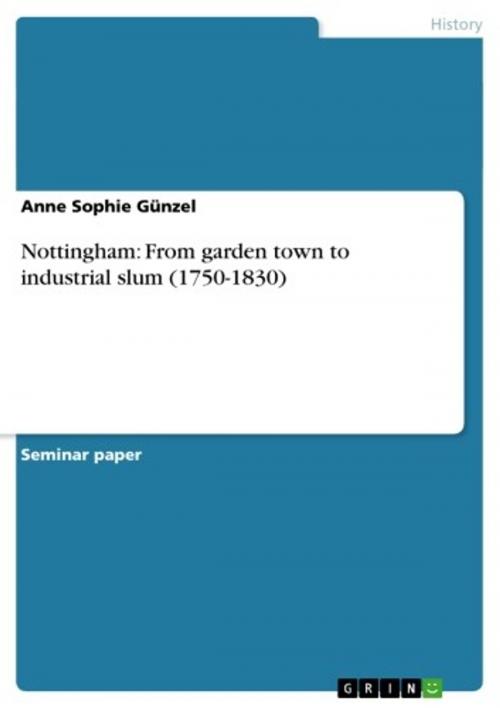| Author: | Anne Sophie Günzel | ISBN: | 9783638266444 |
| Publisher: | GRIN Publishing | Publication: | April 8, 2004 |
| Imprint: | GRIN Publishing | Language: | English |
| Author: | Anne Sophie Günzel |
| ISBN: | 9783638266444 |
| Publisher: | GRIN Publishing |
| Publication: | April 8, 2004 |
| Imprint: | GRIN Publishing |
| Language: | English |
Seminar paper from the year 2004 in the subject History Europe - Other Countries - Modern Times, Absolutism, Industrialization, grade: 70% in England und 1,0 in D, University of Nottingham (School of History), course: Advanced Seminar, language: English, abstract: 'The streets, houses, and market-place here broad, cleanly, and elegant.' With these words a German traveller described Nottingham in the early 1780s. In contrast to this another contemporary stated only a decade later that, the streets are in general covered of the blackest kind, which sable hue is principally contracted from the dust of coal carts; and on a rainy day the heads of the passengers are saluted with streams of water from long projecting spouts issuing from the tops of the houses. The lighting and paving are articles which also require much improvement. It is obvious that during this time Nottingham experienced a considerable physical change, which transformed the elegant Georgian town of 1750 into a dirty and filthy industrial slum by 1830. During that period Nottingham had considerable problems with its population and its housing situation and could only helplessly watch its own decline. Especially, after the refuse of the corporation to enclose the open spaces in 1787, Nottingham had no real ways to escape its disastrous situation. This essay will focus on the transformation of Nottingham during the period from 1750 to 1830 when the town had first the standing of a garden town and then the reputation of one of the worst slum areas in the country. In particular, it will focus on the population and the housing situation during that period. In addition to that, accounts of contemporaries who lived in or visited Nottingham will be mentioned to illustrate the change within the town of Nottingham. This essay will firstly examine the conditions and circumstances of the population and the housing situation in Nottingham when it was a garden town so from about 1750 to 1790/1800. Then in the third chapter Nottingham's population growth and its changed housing situation will be discussed during Nottingham's time as an industrial slum so from 1800 to 1830. In conclusion, the last chapter shall analyse the conditions of the years after 1830. It will attempt to understand why, within eighty years from about 1750 to 1830, Nottingham changed its physical appearance so dramatically and which reasons contributed to this transformation from a picturesque garden town to an filthy industrial slum. Furthermore, it should make clear the conditions of the population, especially the working-classes who lived in the centre of Nottingham which became the slum area. It should make also clear that the people [...]
Seminar paper from the year 2004 in the subject History Europe - Other Countries - Modern Times, Absolutism, Industrialization, grade: 70% in England und 1,0 in D, University of Nottingham (School of History), course: Advanced Seminar, language: English, abstract: 'The streets, houses, and market-place here broad, cleanly, and elegant.' With these words a German traveller described Nottingham in the early 1780s. In contrast to this another contemporary stated only a decade later that, the streets are in general covered of the blackest kind, which sable hue is principally contracted from the dust of coal carts; and on a rainy day the heads of the passengers are saluted with streams of water from long projecting spouts issuing from the tops of the houses. The lighting and paving are articles which also require much improvement. It is obvious that during this time Nottingham experienced a considerable physical change, which transformed the elegant Georgian town of 1750 into a dirty and filthy industrial slum by 1830. During that period Nottingham had considerable problems with its population and its housing situation and could only helplessly watch its own decline. Especially, after the refuse of the corporation to enclose the open spaces in 1787, Nottingham had no real ways to escape its disastrous situation. This essay will focus on the transformation of Nottingham during the period from 1750 to 1830 when the town had first the standing of a garden town and then the reputation of one of the worst slum areas in the country. In particular, it will focus on the population and the housing situation during that period. In addition to that, accounts of contemporaries who lived in or visited Nottingham will be mentioned to illustrate the change within the town of Nottingham. This essay will firstly examine the conditions and circumstances of the population and the housing situation in Nottingham when it was a garden town so from about 1750 to 1790/1800. Then in the third chapter Nottingham's population growth and its changed housing situation will be discussed during Nottingham's time as an industrial slum so from 1800 to 1830. In conclusion, the last chapter shall analyse the conditions of the years after 1830. It will attempt to understand why, within eighty years from about 1750 to 1830, Nottingham changed its physical appearance so dramatically and which reasons contributed to this transformation from a picturesque garden town to an filthy industrial slum. Furthermore, it should make clear the conditions of the population, especially the working-classes who lived in the centre of Nottingham which became the slum area. It should make also clear that the people [...]















